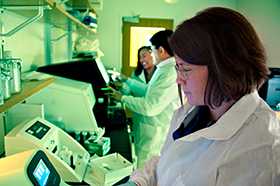Enteric Diseases Laboratory Branch

PulseNet is celebrating 20 years of public health achievements in transforming the way we detect and investigate foodborne disease outbreaks… More

Since 1996, PulseNet has connected foodborne illness cases together, using DNA “fingerprinting” of the bacteria making people sick, to detect and define outbreaks… More

They’re usually in bowls of mixed nuts that are a holiday staple. But for 8 people who lived in Michigan, Wisconsin, and Minnesota, the 2010 holidays weren’t so merry… More

Volume 18, Number 3 – March 2012, Timothy F. Jones (Tennessee Department of Health) and Peter Gerner-Smidt (CDC)… More

CDC’s lead group for the use of molecular subtyping in the national and international surveillance of foodborne infections
Activities
- Managing PulseNet—helping all states to detect, investigate, and control outbreaks
- Partnering with reference laboratories throughout the world
- Building capacity for molecular surveillance of foodborne infections
Teams
National Antimicrobial Resistance Surveillance Team (NARST)
The National Antimicrobial Resistance Surveillance Team conducts antimicrobial resistance surveillance and applied research among foodborne enteric bacteria (pathogens and commensal organisms). Susceptibility testing and other analyses are performed on bacterial isolates from foodborne disease outbreaks, focus studies, and human isolate submissions to the National Antimicrobial Resistance Monitoring System (NARMS). NARMS is a collaboration between the Centers for Disease Control and Prevention (CDC), the Food and Drug Administration Center for Veterinary Medicine (FDA-CVM), and the United States Department of Agricultural Research Service (USDA-ARS). NARMS human isolate monitoring is conducted in partnership with the Enteric Diseases Epidemiology Surveillance Branch; FDA-CVM and USDA-ARS conduct studies on bacteria isolated from retail meats and food animals, respectively.
Additional Links
- Centers for Disease Control and Prevention – Antimicrobial Resistance
- Select CDC NARMS Publications
- NARMS – Food and Drug Administration Center for Veterinary Medicine
- NARMS – United States Department of Agriculture Agricultural Research Service
- Canadian Integrated Program for Antimicrobial Resistance Surveillance (CIPARS)
- European Committee on Antimicrobial Susceptibility Testing (EUCAST)
National Botulism Laboratory Team
The National Botulism Laboratory Team (NBLT) maintains CDC expertise for laboratory investigations of botulism, and provides training to U.S. and international public health laboratories. NBLT outbreak activities include detection and serotyping of botulinum neurotoxin, and the isolation and identification of botulinum-toxin-producing Clostridia. NBLT also develops and validates new detection and identification methods for the enhancement of the U.S. response to bioterrorism events involving botulinum toxin.
Additional Links
National Enteric Reference Laboratory Team
The National Enteric Reference Laboratory Team is comprised of four Units: the Campylobacter Unit; Escherichia, Shigella, Yersinia, and Vibrio Unit; the Salmonella Unit; and the Listeria Identification and Subtyping Unit. The Reference Laboratory Team contributes to the prevention of foodborne and diarrheal diseases in the United States and abroad by facilitating detection, identification and characterization of enteric bacterial pathogens. Members of the Team accomplish this goal by providing reference diagnostic services for unusual or difficult to identify bacteria and by providing consultation and training to empower our public health partners at local, national and international levels to provide quality diagnostic services to their constituents and reliable surveillance data upon which sound public health decisions can be made. To sustain our ability to provide quality service, the National Enteric Reference Laboratory Team conducts applied research to better understand the biology, pathogenesis and epidemiology of enteric bacterial pathogens and to develop improved diagnostic methods for their detection and characterization.
Additional Links
PulseNet USA Team
PulseNet is a national laboratory network that connects foodborne illness cases to detect outbreaks. PulseNet uses DNA fingerprinting, or patterns of bacteria making people sick, to detect thousands of local and multistate outbreaks. Since the network began in 1996, PulseNet has improved our food safety systems through identifying outbreaks early. This allows investigators to find the source, alert the public sooner, and identify gaps in our food safety systems that would not otherwise be recognized. PulseNet International performs a similar role for foodborne illnesses globally.
Laboratory protocols and resources
- Enteric diseases isolate submission memo to state laboratories [PDF – 4 pages]
- Enteric diseases isolate submission table [PDF – 1 page]
- Global Foodborne Infections Network (GFN) lab manuals
- GFN Manual for the laboratory identification and antimicrobial susceptibility testing of bacterial pathogens of public health concern in the developing world
- Clinical Laboratory Improvement Amendments (CLIA)
- PulseNet Methods: PFGE, MLVA, and WGS protocols
- Page last reviewed: May 2, 2016
- Page last updated: May 2, 2016
- Content source:


 ShareCompartir
ShareCompartir